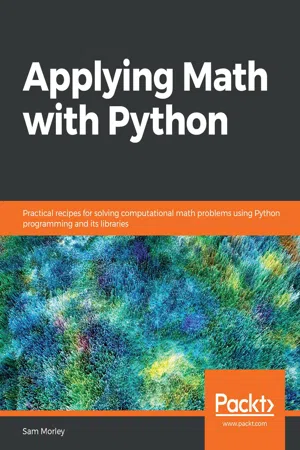
Applying Math with Python
Practical recipes for solving computational math problems using Python programming and its libraries
- 358 pages
- English
- ePUB (mobile friendly)
- Available on iOS & Android
Applying Math with Python
Practical recipes for solving computational math problems using Python programming and its libraries
About This Book
Discover easy-to-follow solutions and techniques to help you to implement applied mathematical concepts such as probability, calculus, and equations using Python's numeric and scientific libraries
Key Features
- Compute complex mathematical problems using programming logic with the help of step-by-step recipes
- Learn how to utilize Python's libraries for computation, mathematical modeling, and statistics
- Discover simple yet effective techniques for solving mathematical equations and apply them in real-world statistics
Book Description
Python, one of the world's most popular programming languages, has a number of powerful packages to help you tackle complex mathematical problems in a simple and efficient way. These core capabilities help programmers pave the way for building exciting applications in various domains, such as machine learning and data science, using knowledge in the computational mathematics domain.
The book teaches you how to solve problems faced in a wide variety of mathematical fields, including calculus, probability, statistics and data science, graph theory, optimization, and geometry. You'll start by developing core skills and learning about packages covered in Python's scientific stack, including NumPy, SciPy, and Matplotlib. As you advance, you'll get to grips with more advanced topics of calculus, probability, and networks (graph theory). After you gain a solid understanding of these topics, you'll discover Python's applications in data science and statistics, forecasting, geometry, and optimization. The final chapters will take you through a collection of miscellaneous problems, including working with specific data formats and accelerating code.
By the end of this book, you'll have an arsenal of practical coding solutions that can be used and modified to solve a wide range of practical problems in computational mathematics and data science.
What you will learn
- Get familiar with basic packages, tools, and libraries in Python for solving mathematical problems
- Explore various techniques that will help you to solve computational mathematical problems
- Understand the core concepts of applied mathematics and how you can apply them in computer science
- Discover how to choose the most suitable package, tool, or technique to solve a certain problem
- Implement basic mathematical plotting, change plot styles, and add labels to the plots using Matplotlib
- Get to grips with probability theory with the Bayesian inference and Markov Chain Monte Carlo (MCMC) methods
Who this book is for
This book is for professional programmers and students looking to solve mathematical problems computationally using Python. Advanced mathematics knowledge is not a requirement, but a basic knowledge of mathematics will help you to get the most out of this book. The book assumes familiarity with Python concepts of data structures.
Frequently asked questions
Information
- Working with polynomials and calculus
- Differentiating and integrating symbolically using SymPy
- Solving equations
- Integrating functions numerically using SciPy
- Solving simple differential equations numerically
- Solving systems of differential equations
- Solving partial differential equations numerically
- Using discrete Fourier transforms for signal processing
Technical requirements
python3.8 -m pip install sympy
Working with polynomials and calculus

Getting ready
How to do it...
- Let's start by defining a simple class to represent a polynomial:
class Polynomial:
"""Basic polynomial class"""
def __init__(self, coeffs):
self.coeffs = coeffs
def __repr__(self):
return f"Polynomial({repr(self.coeffs)})"
def __call__(self, x):
return sum(coeff*x**i for i, coeff
in enumerate(self.coeffs))
- Now that we have defined a basic class for a polynomial, we can move on to implement the differentiation and integration operations for this Polynomial class to illustrate how these operations change polynomials. We start with differentiation. We generate new coefficients by multiplying each element in the current list of coefficients without the first element. We use this new list of coefficients to create a new Polynomial instance that is returned:
def differentiate(self):
"""Differentiate the polynomial and return the derivative"""
coeffs = [i*c for i, c in enumerate(self.coeffs[1:], start=1)]
return Polynomial(coeffs)
- To implement the integration method, we need to create a new list of coefficients containing the new constant (converted to a float for consistency) given by the argument. We then add to this list of coefficients the old coefficients divided by their new position in the list:
def integrate(self, constant=0):
"""Integrate the polynomial, returning the integral"""
coeffs = [float(constant)]
coeffs += [c/i for i, c in enumerate(self.coeffs, start=1)]
return Polynomial(coeffs)
- Finally, to make sure these methods work as expected, we should test these two methods with a simple case. We can check this using a very simple polynomial, such as x2 - 2x + 1:
p = Polynomial([1, -2, 1])
p.differentiate()
# Polynomial([-2, 2])
p.integrate(constant=1)
# Polynomial([1.0, 1.0, -1.0, 0.3333333333])
How it works...
Table of contents
- Title Page
- Copyright and Credits
- Dedication
- About Packt
- Contributors
- Preface
- Basic Packages, Functions, and Concepts
- Mathematical Plotting with Matplotlib
- Calculus and Differential Equations
- Working with Randomness and Probability
- Working with Trees and Networks
- Working with Data and Statistics
- Regression and Forecasting
- Geometric Problems
- Finding Optimal Solutions
- Miscellaneous Topics
- Other Books You May Enjoy